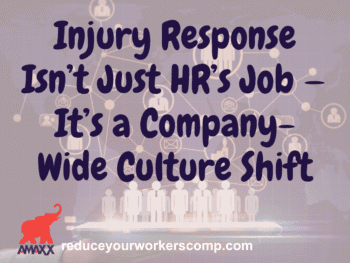
Unlike other substance abuse items, alcohol puts one toxic component (ethanol), in the body. This tends to limit damage for underlying pathologies. Still, over time alcohol can have pronounced effects on health, life style, and job performance. Slowness of comprehension and speech, malnutrition, poor job performance, loss of personal hygiene and appearance are to be observed. Frequent confrontations with fellow and supervisory personnel are often a sign that the employee’s behavior is not normal. There may be physical deterioration such as weight loss, slower physical responses and judgment issues. The most commonly known damage occurs in the liver.
Click Link to Access Free PDF Download
“9-Element Blueprint To Create Your Workers’ Comp Employee Brochure”
Policy
Set guidelines that are legal, clear, comprehensive and enforceable. Obtain professional assistance in developing the plan. Include methods of dealing with enforcements, punishments, and confrontation. It is also a wise idea to have a rehabilitation program as an alternative to termination. A good employee is worth salvaging. Be sure every employee is made aware of the program and obtain their written confirmations.
Front Line Notice
It must be noted that many persons with alcohol abuse issues may easily subdue the outward signs of alcoholism. This makes it difficult for the employer to realize a problem exists. It behooves the immediate supervisor in close contact with the employee to observe and document any changes in the employee’s behavior, attitude, or other outward appearances noted above.
One sign that the employee may be drinking on the job is a change in personality after arriving on the job. Dullness to euphoria or vice-versa is often a sure sign. Frequent visits to the restroom or locker room with changes of personality after return are another sign. Containers with alcohol can be easily hidden under clothing. Thermos or other liquid holding containers may even be in plain sight.
Approach
Great care needs to be taken in confronting the employee for an alcohol situation. Any case controverted by the employer needs proper preparation for defense.
Begin by careful and complete documenting of events, situations and observances by supervisory persons. Make note of fellow employee complaints (these should come from the employee and not solicited by the supervisor). However, once the offending employee is challenged it may be necessary to obtain statements form these employees to act as witnesses.
Obtaining a medical physical examination must be considered. The doctor will also serve as an expert witness to confirm the alcohol problem.
Be certain that the confrontations and claim denials are done in accordance with the alcohol policy.
Rehabilitation
When the employee is valued enough to merit retention, supply a rehabilitation effort to correct the alcoholic abuses. Such programs could be relatively inexpensive and done in accordance with local government sponsored rehabilitation programs for substance abuses. Monitoring the progress is often all that the employer need do.
Work with the employee to re-establish a working relationship with fellow employees. This will also show the fellow employees that the employer has employee best interests at heart.
Summary
Injuries on the job caused by the employee’s alcohol abuse can be successfully defended for declination of benefits. However, the employer has a heavy burden of proof to have a successful ruling by a workers compensation judge or referee. Policies for alcohol abuse must be properly established and enforced. Strong investigation and evidence gathering is mandatory for a successful denial of benefits and medical care.
If the employee is valued, vocational and/or medical rehabilitation might be a contingent for allowing a compensation claim to be absolved.
 Author Michael Stack, CEO Amaxx LLC. He is an expert in workers’ compensation cost containment systems and helps employers reduce their workers’ comp costs by 20% to 50%. He works as a consultant to large and mid-market clients, is a co-author of Your Ultimate Guide To Mastering Workers Comp Costs, a comprehensive step-by-step manual of cost containment strategies based on hands-on field experience, and is the founder & lead trainer of Amaxx Workers’ Comp Training Center, which offers the Certified Master of Workers’ Compensation national designation.
Author Michael Stack, CEO Amaxx LLC. He is an expert in workers’ compensation cost containment systems and helps employers reduce their workers’ comp costs by 20% to 50%. He works as a consultant to large and mid-market clients, is a co-author of Your Ultimate Guide To Mastering Workers Comp Costs, a comprehensive step-by-step manual of cost containment strategies based on hands-on field experience, and is the founder & lead trainer of Amaxx Workers’ Comp Training Center, which offers the Certified Master of Workers’ Compensation national designation.
Contact: mstack@reduceyourworkerscomp.com.
Workers’ Comp Roundup Blog: http://blog.reduceyourworkerscomp.com/
©2021 Amaxx LLC. All rights reserved under International Copyright Law.
Do not use this information without independent verification. All state laws vary. You should consult with your insurance broker, attorney, or qualified professional.

















